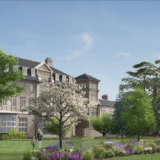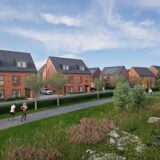Manchester is no stranger to regeneration, but few projects have the scale, ambition, and potential impact of Manchester United’s £2 billion redevelopment vision. At the centre of the proposal is a world-class stadium to replace or radically transform Old Trafford, but the broader plan extends far beyond football. For property investors, it raises pressing questions about value, opportunity and timing.
A landmark project with wide ambitions
The club has engaged renowned architects Foster + Partners to design a modern, 100,000-seat stadium. While this alone is headline-grabbing, it forms part of a wider regeneration framework that spans hundreds of acres in the Trafford area. Early estimates suggest the project could support the creation of tens of thousands of jobs, bring thousands of new homes to the area, and deliver billions in long-term economic value.
A larger, more modern stadium is likely to intensify fan engagement, with supporters making more regular visits to the ground to watch matches and backing their team more consistently. Many will also follow fixtures remotely or stream coverage through digital sports platforms, including betting sites not on Gamstop, where they can access live streaming, 24/7 in-play markets, competitive match-day odds, international payment options and flexible staking limits to wager on their favourite team. These sustained fan behaviours not only strengthen loyalty to the club but also increase spending across hospitality, retail and leisure, extending the economic benefits of the redevelopment across Old Trafford, Salford and central Manchester.
How it could shape Manchester’s property market
For investors, the attraction lies in the ripple effect such a project could create. Large-scale urban regeneration tends to push demand into surrounding zones, and Trafford is already on the radar for developers and landlords. With Old Trafford positioned within the Western Gateway identified in Greater Manchester’s 10 billion euros growth locations plan, a modern stadium combined with new transport links and improved public realm would almost certainly increase land values and rental demand across districts including Old Trafford, Stretford and Trafford Park.
Salford and parts of central Manchester are also likely to feel the impact. With additional housing demand projected under both the club’s redevelopment vision and the regional growth strategy, the appeal of build-to-rent schemes, co-living developments and mixed-use sites will increase. Those who secure positions early could benefit from significant capital appreciation as the scheme progresses.
The importance of timing
Investors must weigh the project timeline. Even if approvals and land deals proceed smoothly, construction on this scale is a multi-year undertaking. Manchester United aims to deliver the new stadium by the end of the decade, around 2030. For property investors, this calls for medium- to long-term plays rather than short-term flips. Early opportunities may lie in acquiring undervalued assets near transport corridors or in adjacent neighbourhoods not yet fully priced, as those who wait until construction begins may find the most obvious gains already captured.
Risks to consider
While the opportunity is clear, investors must be aware of challenges. Land acquisition is one immediate hurdle. Reports highlight a significant gap between Manchester United’s valuation of certain sites and the price expectations of current owners. Bridging this gap is critical for the wider vision to advance.
There is also the matter of financing. Delivering a £2 billion stadium and additional regeneration infrastructure requires significant capital, whether through private funding, partnerships or public support. If financial structures are delayed, parts of the scheme could be phased or scaled back.
Finally, market cycles matter. Property values in Manchester have been robust in recent years, supported by strong population growth, a thriving student market and a growing technology sector. However, investors must keep an eye on wider economic conditions and interest rate trends, as these could influence rental demand and financing costs.
The bottom line
Manchester United’s £2 billion vision is about more than football. It is a regeneration blueprint that could reshape one of the city’s most recognisable areas and open a new era of opportunity for property investors. While risks around land, funding and timing remain, the scale of the ambition ensures this is a development that cannot be ignored.
For investors with patience and a strategic eye, positioning near Trafford today could mean being at the forefront of one of the most significant property stories in the UK over the next decade.






